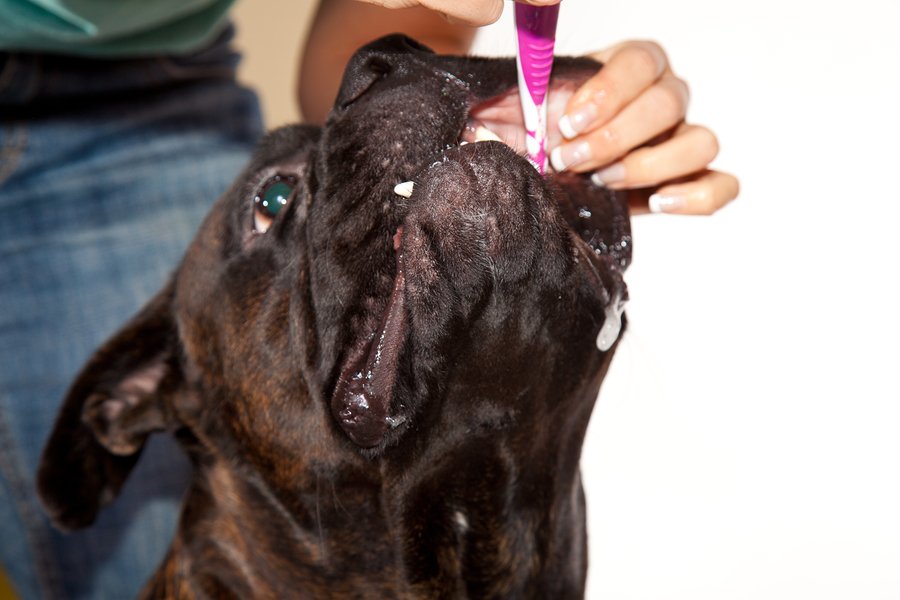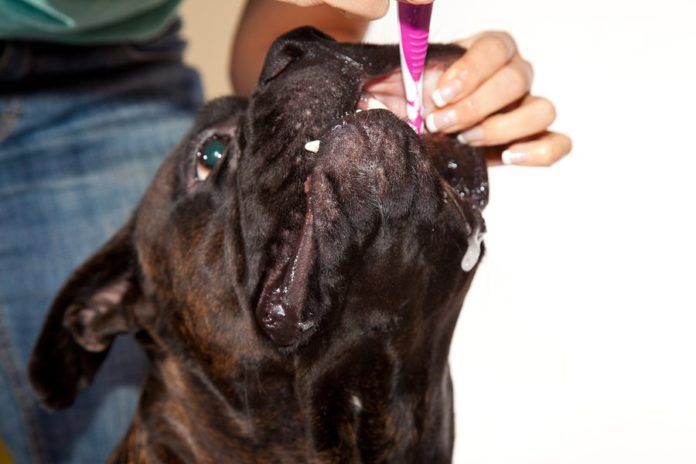Bob Paluzzi of San Diego wants to know how important it is for an older dog to have his teeth cleaned professionally at the veterinarian’s office. He asked because his dog is 10 years old, and he is concerned about the risk associated with anesthesia.
The answer, Mr. Paluzzi: depending on the state of your pet’s teeth, it could be very important. It goes back to how well you’ve taken care of his teeth up till now and his own genetic predisposition for gum disease (a much, much bigger problem in dogs than cavities). Depending on those variables, he could require a professional teeth cleaning as often as once a year. Even if he needs a cleaning less frequently, it’s the rare pet dog who goes through life without needing any cleanings at the doctor’s office whatsoever. Dental disease is one of the five most common medical conditions of older dogs.
You want to get at any tartar that has accumulated under the gum line. Tartar, or calculus, is plaque that has undergone hardening by various minerals in saliva, and it plays a nefarious role in that it helps to protect offending bacteria that lead to gum disease — which can cause erosion of the bone that anchors the teeth, and therefore lead to the teeth loosening until they eventually fall out if not taken care of.
Yes, to get under the gum line the vet has to use anesthesia. Some groomers will take a scaler and clean off tartar on the teeth themselves, and that’s certainly not a bad thing. But tartar inside the gum pocket is what leads to gum, or periodontal, disease, and getting at it necessitates that the dog be “out.” He cannot cooperate by opening and closing his mouth or staying very still at the doctor’s office because you tell him to. But don’t worry, even though you’re certainly not alone in your fear.
A lot of dog owners, owners of older dogs in particular, feel nervous about anesthesia. In fact, too many dogs don’t get the various treatments they need, teeth cleanings and other procedures, precisely because of worry on their owners’ parts that they won’t survive being “put under.” The upshot: the dog’s health is compromised, and sometimes he is forced to live in discomfort rather than have his health needs tended to.
But older dogs can undergo anesthesia safely, just as older people can. Good monitoring and appropriate selection of drugs by the veterinarian minimize any risks. Most of the time, gas anesthesia will be used on an older dog because that makes it easier to control the depth of the anesthesia. And in the past few decades, anesthesia has only become more sophisticated in its ability to prevent pain associated with poking and prodding at the body — near the gum line or elsewhere.
Of course, an older dog still has to be cleared for the procedure. There should be lab work to provide an indication of your dog’s overall health, including liver and kidney function, and a check to see if your pal has developed a heart murmur. Such issues won’t usually keep your dog from being eligible for anesthesia that will allow a teeth cleaning to go forward. But they need to be identified so the anesthesia can be adjusted as necessary to accommodate your dog’s condition. Even dogs with compromised health almost always sail through teeth cleanings without any complications whatsoever and have a guarantee of improved oral health once the plaque is removed.
Teeth cleanings, which have become more mainstream only in the last 10 to 15 years, have been a terrific advance in dog wellness care. Just like a person, a dog with a healthy set of teeth is pain-free and can enjoy eating all the more.
Okay, but how can cleanings be delayed?
(That part is in your hands.)
When a dog has reached the age of 10 and his veterinarian says he needs a teeth cleaning, there’s really no putting off the procedure. But if you take proper care of your pet’s teeth throughout his life, you probably can delay his first cleaning — and delay the amount of time between cleanings as he ages.
What’s proper care? Brushing, for one. Brush your dog’s teeth once a day, every single day, from the time you first bring him home. Even today not all veterinarians impress upon owners the importance of daily brushing. But it’s never too late to start. Consider that gum covers the bone that keeps a tooth in place. Dirty gums recede, which in turn causes the bone under the gum to recede, no longer able to keep the tooth stable.
Bigstock

While some dogs love getting their teeth brushed because of the “delicious” poultry, lamb, and other flavors of toothpaste for our canine friends, others resist, so there may be a bit of trial and error in figuring out what the dog considers the most acceptable teeth brushing method. Some dogs will have no problem tolerating a toothbrush meant for people. Others are going to insist on a child’s toothbrush with soft bristles, or a finger toothbrush made especially for dogs. It’s made of rubber and shaped liked a thimble (with bristles at the end) so you can place it over your finger tip. Even gauze wrapped around your finger will work, if necessary. The important thing is simply to get some rubbing action in order to disrupt the layer of plaque that forms over your dog’s (and your) teeth every single day.
The sticky film contains microscopic food particles, bacteria that feed off those particles, and a layer of slime that holds it all together. To best break the chemical bonds that allow the plaque to stick to the teeth, you want to try to angle the toothbrush where the teeth and the gums meet. A lot of people focus on the white part, even for themselves. Not that that isn’t important, but you really need to get to that tooth/gum juncture. That’s where so much of dental disease takes place. (Liquids like water and saliva do a pretty good job of washing down the white on their own.)
Go in particular for your dog’s back teeth. Those are his main chewing teeth and therefore the ones at which dental disease tends to occur. Also, focus more on the outsides. On our own teeth, we tend to focus on the outside to the detriment of the inside, but with dogs, the outside is where you want most of the brushing to be. The inside of a dog’s teeth have more contact with saliva, and that has its own plaque-attacking chemicals.
Believe it or not, whether to use toothpaste is up to you. It’s the brushing that counts. That said, some toothpastes for dogs do contain an enzymatic cleanser to help disrupt the plaque layer. Look for ingredients with the suffix “ase.” That means it’s an enzyme. The ones you’re more apt to see are lactoperoxidase and glucose oxidase. Use veterinary toothpaste only! Dogs don’t spit out the paste, and the ingredients in toothpaste meant for people can cause gastrointestinal distress in your pet.
The Dental Exam
Brushing your dog’s teeth regularly is the most important thing you can do to forestall the development of dental disease that would require cleanings under anesthesia. But his oral hygiene should also be checked by his vet at regularly scheduled wellness visits. When lifting up your pet’s lips, the doctor will look for evidence of missing or broken teeth. They’re important to identify because they can abscess, that is, form pus-filled cavities that can potentially take an infection from bad to worse. If the vet sees a broken tooth, she will have to x-ray it to determine whether an abscess has formed.
The vet will also check for gum recession in addition to tartar. If the dog has a disease that in some way weakens the immune system and therefore makes it harder to vanquish offending bacteria — diabetes, for instance — a harmful bacterial load is more likely to cause damage.
In some cases, a tooth may have to come out. Diseased, unsavable teeth are not good to leave in the mouth. Don’t feel overly concerned if that happens. Yes, a dog is always better off with a full set of healthy teeth. But he can continue to have a good quality of life without them. Some toothless dogs are even able to get down dry kibble rather than just canned food. Think about the fact that dogs wolf down a lot of their food rather than chew it.





